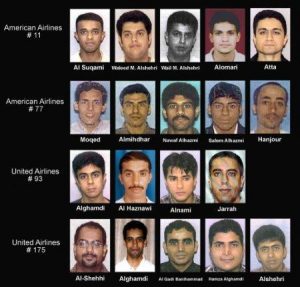
Our immigration system is a mess, and it has been for a very long time. Prior to 9/11 this was not an issue to which anyone paid much attention, but in the fourteen years since then, it should have demanded much more scrutiny than it has. The nineteen hijackers of September 11 entered the United States legally, one on a student visa (F or M visas), others on business (B-1 visas) or tourist (B-2) visas (more here). Aside from some overstaying their visas, they passed through the system without raising any suspicions. The terrorists were way ahead of us on abusing the system.

The abuse continues as was starkly illustrated on December 2, 2015 in San Bernardino where Tashfeen Malik, who entered the US on a fiancé visa (K) carried out a terrorist attack with her American born husband, Syed Farook. Tashfeen also entered the US with government approval, despite having falsified some information on her application.
As the investigation continues into the San Bernardino attacks, Farook’s American friend Enrique Marquez, 24, is becoming central to piecing together information about Farook and Tashfeen. Marquez bought the AR-15 type rifles used in the attack, and it is reported that he bought them specifically to give to Farook.

This is called a straw purchase and it is illegal (so much for keeping guns away from criminals by forbidding straw purchases). But Marquez is also guilty of committing immigration fraud himself if the reports are correct. He is apparently married to a Russian woman, who is the sister of the wife of Farook’s brother. We don’t have enough information to know if Farook’s brother’s marriage is legitimate, but it seems clear that Marquez’ marriage is not.

Marquez told friends that he married Mariya Chernykh in 2014, but that the marriage was a sham. The wife lived separately from Marquez and would not be intimate with him. He told colleagues that he was paid either $5,000 or $10,000 to enter into this marriage. The wife and her sister entered the US on J-1 visas, cultural exchange visas, which allow for a specified period of time to to stay in the US. You may adjust status from a J-1 visa, such as seek a green card, if you marry an American citizen.
Several years ago, when I was still actively practicing law, I was aware of some interesting immigration cases. There were three sailors from the Philippines who entered the US on C visas which permit a short entry for foreign seaman, but are not visas that allow adjustment to a resident status. In other words, if you have a C visa you must go back home, apply for another type of visa that would allow you a path to a green card, and then return. Of course this would literally take years, if not decades, to properly pass through the system, so despite the regulation prohibiting adjustment from this visa, the sailors decided to submit applications to become residents.
All the sailors were married to American women living in the area, and none of them posed a security threat. They did not lie on their applications or hide any information, and their marriages were legitimate so far as I know. For all practical purposes the three nearly identical applications should have been denied, but surprisingly and without explanation, two of the three applications were approved. The third sailor whose application was denied should have been deported, but to my knowledge he never left the US.
My opinion formed on our immigration system is based on that story and a few others that illustrate the complete arbitrariness of the system. The legal process is sometimes as long as a lifetime. There are waiting lists that range from a few months, to approaching twenty years, depending on the country the applicant is immigrating from. Mexico had the longest waiting time, Philippines was very close behind. This lengthy process is mostly unfathomable for most people, and so they look for ways to skirt the system. Usually they will enter legally through a short visa, but then overstay, despite the harsh penalties if caught. Through the current culture of lack of enforcement, it is a risk many are willing to take. Others, as we are well aware, don’t bother with a visa and simply stream over the border in an undocumented status. They remain that way, live in the “shadows” and manage to create a life of some sort here. For many their only crime will be entering the US illegally, but some are criminals who take advantage of the US time and again.
There is a lot of shouting about what to do about the problems with immigration, with most talking past each other by accusing the other side of being inhumane and unchristian, or by spewing out proposals that won’t adequately address the problem areas. The US takes in tens of thousands of people each year through many different types of visas or visa waivers. The entire system needs major attention and a halt or radical slow-down to processing applications should take place as we consider improvements. We should not consider whether anyone’s feelings are going to be hurt; we should instead focus on solutions that are targeted to the weaknesses of the system and that currently allow for the weakening of America.
Leave a Reply